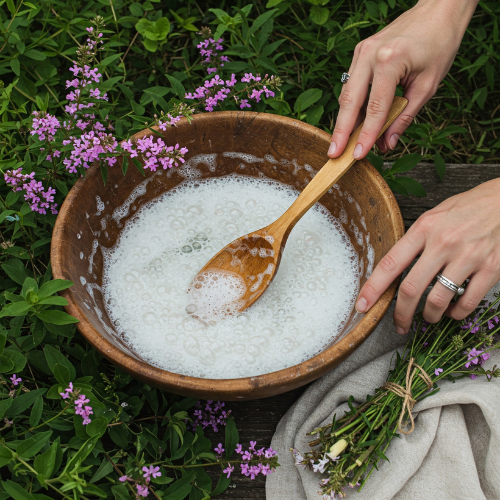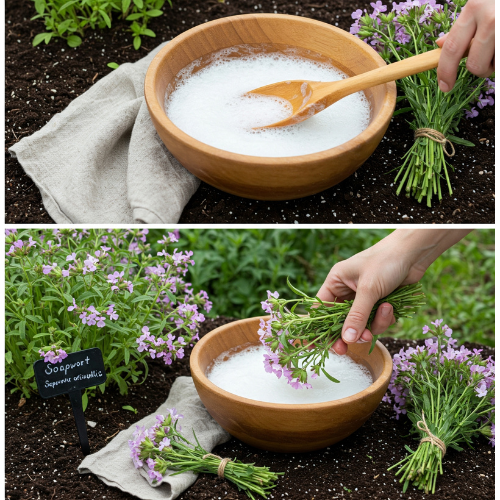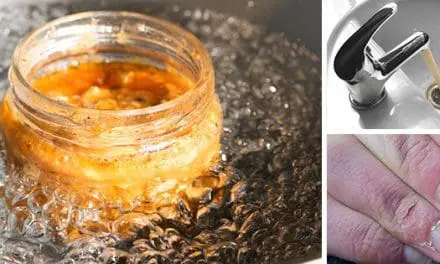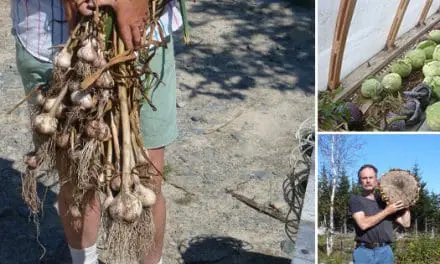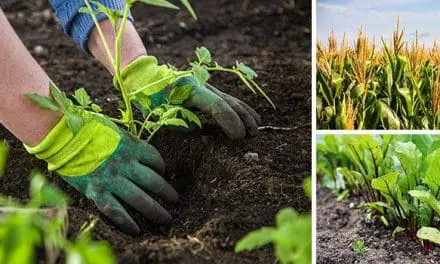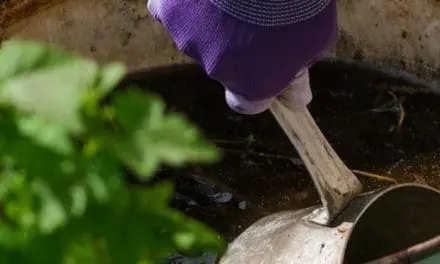Most people see a weed. They yank it out and toss it on the compost pile without a second thought.
But a few generations ago, this weed was worth its weight in gold – especially if you were living off the land.
Early pioneers and Native tribes knew exactly what to do with it. It was a simple solution that still works wonders today.
And you might already have it growing just a few steps from your door.
A Short History Lesson
The plant is called soapwort. Believe it or not, it lathers up like a bar of store-bought soap.
Early pioneers used it to wash clothes, dishes, and even themselves when supplies ran low. And long before that, Native tribes noticed how the crushed leaves and roots foamed up in water. That simple discovery became a good way to wash up without needing anything more.
Soapwort’s story goes back even further. The Romans used it to wash their togas, and its Latin name, Saponaria, comes from “sapo,” meaning soap. Through the Middle Ages, it was a go-to for laundry and delicate fabrics.
These days, hardly anyone remembers what it is, let alone how to use it. It is close to being lost to history. But we can easily change that, right?
Identifying Soapwort
How do you know if you’ve got soapwort growing in your backyard? Look at these elements:
- Leaves: Soapwort has lance-shaped leaves that grow opposite each other on the stem. They’re usually about 1-2 inches long and have smooth edges.
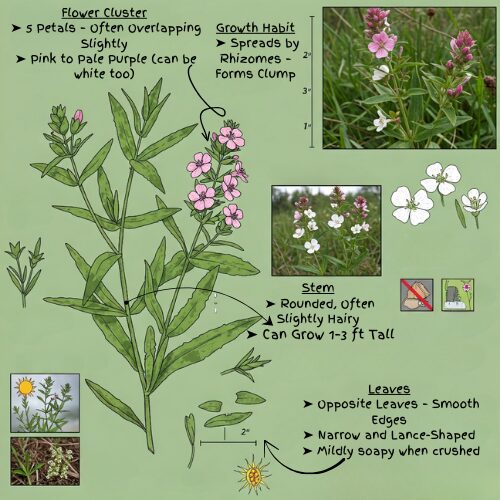
- Flowers: The flowers are the most distinctive feature. They’re typically pink or white, with five petals that spread out wide. They often grow in clusters at the end of the stems. The flowers usually bloom in summer.
- Height: Soapwort plants can grow up to 2 feet tall, so they’re not exactly tiny.
- Location: Soapwort is pretty adaptable and can grow in a variety of conditions, but it prefers sunny spots with well-drained soil. It’s often found along roadsides, in meadows, and, yes, in gardens.
If you’re still not sure, try this simple test: Crush a few leaves in your hands and add a little water. Rub them together vigorously. If you see a soapy lather forming, chances are you’ve found soapwort!
Why Soapwort? The Benefits of Natural Soap
Why bother with soapwort when you can just grab a bottle of soap from the store? Well, there are several good reasons to consider making your own natural soap:
- Gentle on Your Skin: Commercial soaps often contain harsh chemicals that can strip your skin of its natural oils, leading to dryness and irritation. Soapwort is much gentler and less likely to cause problems, especially if you have sensitive skin.

- Control over Ingredients: When you make your own soap, you know exactly what’s going into it. You can choose natural, organic ingredients and avoid any potentially harmful chemicals.
- Self-Reliance: The more you can make yourself, the less you depend on store shelves. Soapwort gives you a simple, renewable way to stay clean without modern supply chains.
- No Power? No Problem: If the grid goes down, you’ll still want a way to wash up. Soapwort doesn’t need electricity, special tools, or preservatives – just a bit of water.
- Safe for Greywater Systems: If you’re using a greywater system on your homestead, natural soapwort won’t harm your garden or soil the way many commercial soaps can.
- Eco-Friendly: Most commercial soaps come in plastic bottles and contain synthetic ingredients that can pollute waterways. Making your own soap with soapwort is a much more sustainable option.
This kind of lifestyle is still alive and well in Amish communities, where people continue to make their own soaps, tinctures, salves, and even all-natural cleaning solutions using nothing more than the plants growing just outside their back door. If you’re curious about how those traditions work (and how you can start using them yourself) there’s a wonderful book you’ll want to check out. It’s based on first-hand, real Amish experience and brings together generations of old wisdom: from timeless remedies and backyard fixes to long-lasting, crisis-proof recipes and off-grid projects that don’t rely on electricity.
🧼Soapwort Soap: A Simple Recipe
Ready to try your hand at making soapwort soap? Here’s a basic recipe to get you started:
Ingredients:
- 1 cup fresh soapwort leaves and stems, chopped
- 4 cups water
- Optional: Essential oils for fragrance (lavender, chamomile, and rose are good choices)
Instructions:
- Combine the chopped soapwort and water in a pot.
- Bring to a boil, then reduce heat and simmer for about 30 minutes, or until the liquid has reduced by about half.
- Strain the mixture through a cheesecloth or fine-mesh sieve to remove the plant material.
- If desired, add a few drops of essential oil for fragrance.
- Let the mixture cool completely. It will thicken slightly as it cools.
- Pour the soap into a jar or bottle and store it in the refrigerator.
🌿🪻🧼Olivia’s Recipe Tricks:
Boost your soap’s benefits and aroma by adding other medicinal plants or natural ingredients you might already have growing in your garden or stored in your pantry! You can toss fresh herbs or dried flowers right into the pot to simmer with the soapwort, letting their healing properties infuse into the liquid. Or, if you’d rather, sprinkle in some dried petals after straining to give your finished soap a decorative, herbal touch. Just be sure to wait until the soap cools down before adding things like aloe, honey, or powders—extreme heat can strip away their benefits.
Here are some additions I like to experiment with:
-
Calendula petals – great for calming irritated skin and minor cuts or scrapes
-
Chamomile – gentle and soothing, especially if you grow it for tea already
-
Lavender buds – naturally antibacterial
-
Rose petals – softens skin and adds a lovely scent
-
Yarrow – helps speed up healing and reduce redness
-
Echinacea – adds a bit of immune support and has antimicrobial properties
If you keep roots and barks on hand, try adding a bit of licorice root for its skin-soothing effects, or oatstraw, which is wonderful for dry, tired skin—especially during the colder months.
Once your soap mixture has cooled a bit, you can stir in things like aloe vera gel from a plant in the window, a spoonful of raw honey from your own hives (or a local source), a dash of milk powder, or a splash of witch hazel for a little extra skin-toning power.
If you’re already reaching for things like calendula, yarrow, or echinacea in your recipes, you’ll surely appreciate having even more ways to put those plants to work. This natural remedies book has become one of the most-used resources on my shelf. I mean, we’re talking about over 200 tried-and-true remedies you can make at home using herbs you most likely already have growing in your backyard or tucked in your pantry!
Here are just some of the 200+ recipes you’ll find inside: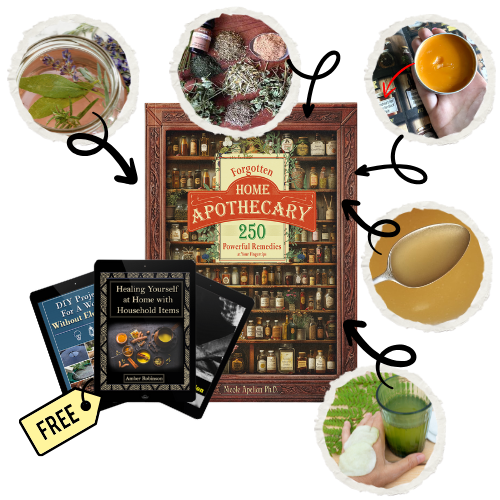
🌸Penicillin Soup – a natural remedy made with powerful antibacterial herbs to help fight off infections
🌸Young Heart Elixir – supports cardiovascular health and helps maintain healthy circulation
🌸Calendula and Comfrey Skin Salve – soothes scrapes, rashes, and minor skin irritations
🌸Yarrow Stop Bleeding Powder – helps quickly stop bleeding from minor cuts and wounds
🌸Herbal Antibiotic Capsules – support your body’s natural defenses using homegrown ingredients
🌸White Cell Boosting Juice – strengthens your immune system when you feel an illness coming on
🌸Anti-Inflammatory Root Infusion – eases inflammation and soreness after a long day of physical work
And I’ve got some more good news for you! I managed to get you a special discount for the book, so if you decide to grab it through this link, you’ll get not just the book itself, but also 3 extra bonuses (normally valued at around $100) completely free. On top of that, you’ll also receive a free Herbal Medicine Video Collection, where Nicole Apelian personally walks you through her most trusted and requested remedies, step by step. That way you can just follow along with her and easily create all the remedies you want.
But here’s the catch—this offer is only available for the first 100 people who click the link, and spots are going fast. So if you’re thinking about it, now’s the time!
How to Use:
To use your soapwort soap, simply wet your hands or a washcloth and apply a small amount of the soap. Lather and rinse as usual. This soap is gentle enough to use on your face and body.
Important:
Always do a patch test before using any new soap on your entire body, especially if you have sensitive skin.
Soapwort soap doesn’t lather as much as commercial soaps, but it still cleans effectively.
This soap is best used within a few weeks, as it doesn’t contain any preservatives.
Beyond Soapwort: Other Soapy Options
Soapwort isn’t the only plant with soap-making potential. Here are a few other options you might already have growing in your garden:
Yucca Root: Yucca plants are common in the southwestern United States. The roots contain saponins, which create a foamy lather when mixed with water.
California Buckeye: The nuts of the California buckeye tree also contain saponins and can be used to make soap. However, they are toxic if ingested, so handle them with care.
Ivy: Common ivy (Hedera helix) contains saponins in its leaves. You can use ivy leaves to make a simple soap by boiling them in water and straining the liquid.
Shikakai: This plant isn’t native to America, but if you live in a warm climate, you may be able to grow it. It is a climbing shrub native to Asia that has been used for centuries in India as a natural hair cleanser. The pods, leaves, and bark of the shikakai plant contain high levels of saponins.
Aritha (Soap Nuts): Similar to shikakai, aritha or soap nuts are commonly used in Ayurvedic medicine as a natural cleanser. The shells of the aritha fruit contain saponins and can be used to make soap for laundry, hair, and body.
Caution
Before you start harvesting plants like soapwort, it’s important to be aware of a few potential risks:
Plant Identification: Make sure you’re absolutely certain about the identity of any plant you plan to use. Some plants are poisonous and can cause skin irritation or other health problems. If you’re unsure, it’s always best to check with a local expert—or use a reliable field guide.
I’d recommend The Forager’s Guide to Wild Foods. It’s packed with clear photos, detailed descriptions, and helpful tips for telling useful plants from the dangerous ones. It’s one of the handiest resources I keep on hand when I’m foraging or working with wild plants.
Allergies: Even if a plant is generally considered safe, you may still be allergic to it. Always do a patch test before using any new plant-based soap on your entire body.
Sustainability: Don’t harvest plants from the wild unless you have permission and are sure that you’re not harming the local ecosystem. It’s always best to grow your own soap-making plants in your garden.
Embracing the Natural Clean
Soapwort might look like just another weed—but it’s anything but useless.
So next time you spot that unassuming patch of green, take a second look. The solution to clean, natural living might be right there under your feet—just waiting to be used again.
If You Have This Plant in Your Backyard, You Will Never Run Out of Soap
How to Make Salt from Plants (Video)


